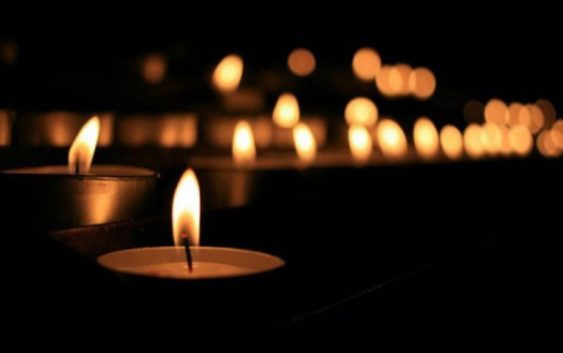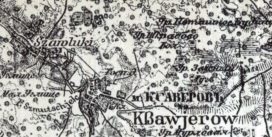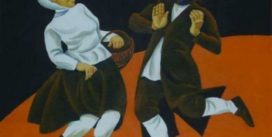In Evidence. Ukrainian neighbors of the Jews speak about their dreadful memoirs

80 years on from the Final Solution in Eastern Europe, Ukrainian eyewitnesses relate for the first time what they saw, and will never forget: The Jewish children, teachers, neighbors, doctors murdered in front of them and buried in pits in villages, forests, and even in schoolyards, for all to see.
The testimonies presented here were taken two years ago and are revealed here for the first time
As a young child, Raisa saw thousands upon thousands of Jews marched to killing fields right by her school where they were shot and left to fall dead or wounded into huge pits. When the schoolchildren walked through the area to gather herbs, they would see the snow covered in blood. “If you collected all the blood here, it would be enough to drown the entire Ukraine,” she says. Galyna was 11 years old when the Jews were murdered in the forest near her home. She remembers the murders, the pits, and the screams of the young boys and girls as they were killed. The Jews are buried in the forest in two mass graves. “We all know that the Jews are there,” she says* Another eyewitness, Lioubyna, recalls how a Jewish girl of only three years old asked her mother on the way to the death pits: “Mother, why are they taking us, I’ve been a good girl.” The witness recalls how three days later the pit was still moving – “The Jews were buried alive.”
The interviews with Ukrainian eyewitnesses, neighbors if the Jews, took place as part of a huge research project led by genocide researcher Father Patrick Desbois. He and his team at Yahad in Unum conducted thousands of interviews with eyewitnesses to the mass murder of Jews in Eastern Europe. The methodologies developed by Father Desbois and his team have been implemented in other places around the world such as Guatemala and Iraq. The interviews are being published here for the first time ahead of International Holocaust Remembrance Day.
In September 2021 the BYHMC academic council, led by Father Desbios, published research on the perpetrators of Babyn Yar (add link). This research is part of the greater goal of the BYHMC academic council mission to identify the people that participated, witnessed, helped, or rescued the Jews of Ukraine and Eastern Europe. Today the testimonies are being revealed for the first time.
Father Patrick Desbios, founder of Yahad In Unum and head of the academic council at the Babyn Yar Holocaust Memorial Center: “The killing of the Jews was the biggest crime of humanity and it should be treated as a crime. My mission is to expose genocides beyond the big names and the big numbers. This terrible crime was very personal, many people were involved in it, and even 80 years later it is important to reveal what happened there.”
Ruslan Kavatsiuk, BYHMC Deputy Director: “The enormous work of Father Patrick and his team at Yahad In Unum to investigate and personalize the Holocaust will play a major part in the Babyn Yar Holocaust Memorial Center. The Academic Council led by Father Desbios is keen to reveal the untold story of the Holocaust in Eastern Europe, the “Holocaust by Bullets.”
These testimonies will be revealed to a delegation of European parliamentarians to Ukraine, organized by the European Jewish Association (EJA) in cooperation with the Babyn Yar Holocaust Memorial Center (BYHMC) and the Federation of Jewish Communities of Ukraine.
Chairman of the European Jewish Association, Rabbi Menachem Margolin said from Kyiv: “We are here to fight back against all those that are still waging Holocaust denial and aiming to obscure the memory of the Holocaust and it’s lessons to humanity. We have brought parliamentarians from across the continent, members of the European Parliament, Jewish leaders, and public figures, to demand on behalf of the victims and their relatives the only effective response against the disappearance of the atrocities and the moral lesson required of them: Significant educational work. This will be our legacy to future generations, ensuring that the heinous crimes of the past are not forgotten, not learned from and not repeated.”
“Believe me, if you collected all the blood here (near the death pits), it would be enough to drown the entire Ukraine in blood”
Raisa was born in 1935 in a small village of Natiahalovka. Jews lived in the village, but most lived in the city center. It was a place of many nationalities, Ukrainians, Russians, Jews, and others. The Germans entered the area in 1941. She was just six years old at the time and she recalls a childhood spent in fear.
She remembers well a Jewish man by the name of Gryshovich who lived near her grandfather and was married to a Ukrainian woman. Gryshovich was the conductor of a local musical ensemble and a popular member of the community. When the Germans entered the town, they forced Gryshovich and the ensemble to play for them. Raisa said that Gryshovich remained in the village throughout the German occupation. But when the Russians began to close in on the area, the Germans decided to kill the remaining Jews.
Raisa recalls: “My grandfather saw the shooting [of the Jews]. I’m not even going to tell you about children because it was just awful, the way they [the Germans] mistreated them. I haven’t seen it myself but according to my grandfather… He didn’t recount it to me, but to my mother and his sons, but me, I listened to him recounting how the Jewish children were killed.” Gryshovich was killed around October or November 1943 and Voznesensk was liberated on March 24, 1944.
But the shootings had begun in 1942. At first, the Germans brought Jews in little by little, Raisa recalls, and not everybody knew that Jews were being shot. “But when they began to bring them by trains to the railway station, to get them off the wagons and to round them up… There were many of them, thousands of people. So when they started to march the groups… the columns [of Jews], at that time everybody knew that the Jews were being shot. Our village was quite small, so everybody knew.”
She recalls how the Jews were marched from morning till noon, and as they arrived, “the Jews had to undress, then they were stripped of their valuables and killed right away.” Jews were brought to Voznesensk from all around the area to be murdered. The Germans had chosen a sight on the outskirts of town that was a wasteland with no vegetation where huge pits were dug. The Jews were stripped naked, their valuables were taken from them and they were shot and fell into the pits. The Germans didn’t shoot the small children, they threw them alive into the pits and buried them. Soviet prisoners of war were brought there to dig the pits and fill them in.
“We heard them being marched. They were talking in Jewish language (Yiddish), crying and shouting. It was awful! There were thousands… of people murdered! And we, the children, we went… But we couldn’t… we didn’t have the right to give them something. We ourselves didn’t have anything. Had we given them something, we would have been shot [by the Germans]. I don’t understand why they were so cruel. Elderly women, children, teenagers were marching there. They carried small children in their arms. It happens that I lay down and try to recall… But I don’t even want to recall all that! All this atrocity!”
Raisa says the Jews carried their belongings as they didn’t know they would be shot. “They were just told that they would be taken somewhere else.”All of this took place right by her school: “Everybody heard it! Everybody! It was a small village. It took place right behind the school. They were shot right behind the school.”
While she didn’t see the shootings, she witnessed “the horror when they were being marched and saw the ground drenched in blood.” Raisa said the Germans would give the local school children an assignment to gather thyme and as they walked through the area they would snow covered in blood. “Believe me, if you collected all the blood here, it would be enough to drown the entire Ukraine in blood,” she says.
“Daughter, we cannot hide you… Go, children, I have my own children, I cannot risk them.”
Galyna was born in the village of Tunyky in the Kyiv region, and was a young girl of 11 years old when the Germans invaded Ukraine. She grew up in abject poverty after her father was disappeared by the Soviets for being a small landowner. Three of her siblings died
during times of famine when they ate loaves of bread that their mother had locked away.
There were no Jews in her village, but there were many in the nearby town of Boguslav before the war. She remembers vividly how not long after entering the village, the Germans killed 35 communists they had rounded up, machine-gunning them to death as they stood above a freshly dug grave not far from the village. The Germans tortured one of them, an 18-year-old girl named Marinka They set their dogs on her because
she recited a poem to them: “You will pay for everything/ The old forest is humming/ the Red Army is coming.”
Not long after that, less than a month later, the Germans started bringing Jews from Bogoslav and shooting them dead in graves by a forest at the border between the village and Bogoslav, not far from the Communists’ grave. One Jewish girl that her family knew spent a night hiding at their house. She was about 16 years old, she came back another night with two friends. Her mother told them: “Daughter, we cannot hide you… Go, children, I have my own children, I cannot risk them.”
Galyna would graze cows near the site, and she recalls seeing four times groups of Jews being shot, over four consecutive days, but those, she says weren’t the only times that Jews were shot there. She and her friends would go to the area on purpose to see what was happening. “Up there at the forest, they were killing the Jews. Not all of them together, but as they would catch them, they would kill them on the spot. Because the Jews were hiding, the poor ones.”
Among those she saw killed was the girl who had come to hide at her family’s house, together with her friends. “Those three girls cried so bitterly that they wanted to live.”
Only two German soldiers carried out the killings, using rifles. She describes how one of the German soldiers didn’t want to shoot and was crying, so another officer hit him in the face, took his rifle, and killed the girl. “‘That girl said, ‘Mr., We want to live.’ The German pointed a gun at her but then lowered it. And the other one was screaming at him to shoot. And he tried again and then started to cry. And the other one hit that German in the face, grabbed his rifle and bang-bang, killed them. The girls fell on top of bodies that were already there.” He shot the girls dead, one by one.
The Jews, Galyna, recalls were shot as they were caught, sometimes in small groups, and sometimes in larger ones, but the grave that had been dug for them was much bigger than for the 35 Communists. How big was the grave? “It was wide, because there were a lot of Jews there, really a lot,” Galyna says.
A second grave was dug about a week after the shootings she and her friends witnessed because the first wasn’t big enough for all the Jews shot there.
On one occasion, Galyna saw a group of 15 Jews being led to the grave, among them children as young as 13. She and her friends were chased away before they could see how the Jews were killed. The Jews were brought to the forest in a truck and then marched along the road to the grave where they were lined up with their backs to the soldiers and shot. This time there were more Germans there.
She remembers how she told her mother about the shootings, and they all cried. When she went with her mother to Boguslav after the shootings there were no Jews left in the town even though she remembers there had been many before the war.
About a week after the killings that she and her friends witnessed, Galyna returned to the site and saw that it had been covered with earth, but the bodies had been piled so high that some of them protruded out of the earth.
Galyna says that the bodies of the Jews murdered at the site are still there in the two graves, which are fenced off. “We all know that the Jews are there.”
Mom, where are we going? I was a good girl, why are you taking me there?”
Lioubyna was born in 1925, in Stara Prylouka and she was interviews recently by Yahad In Unum team:
“One summer day, I saw a column of Jews from nearby villages arriving, escorted by 15 policemen. Local Jews joined them. The police were not armed, they just had sticks. The Jews walked two-by-two, in columns. The police surrounded the column. There were mainly teenagers and old people. I saw a mother with her daughter who was only about 3 years old. The girl kept asking “Mom where are we going? I was a good girl, why are you taking me there?” The mother did not answer. The column arrived at the killing site, the pit was already dug. There were already bodies in the pit; they were Jews from another village.
Three Germans wearing green uniforms were already waiting near the pit. The soldiers were armed with machine guns and rifles. I followed the column and stopped at about 50 meters from the pit. The Jews were undressed, placed in front of the pit, and shot by these three Germans. After the shooting, 3 days later, the pit was still moving”.






